November 10, 2017
Air Date: November 10, 2017
FULL SHOW
SEGMENTS
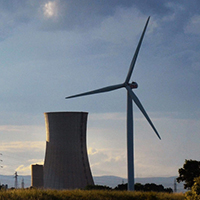
US Hails Atomic Power At Climate COP23
View the page for this story
As global leaders meet for UN climate COP23 talks in Bonn, Germany, the U.S. delegation is promoting carbon-free nuclear energy as part of an “all of the above” strategy for climate protection. Department of Energy Acting Assistant Secretary Edward McGinnis tells host Steve Curwood that advanced nuclear technologies are safer than older systems and can provide base load support for power grids to balance intermittent renewable energy. He also reports the Trump Administration is partnering with US companies to be world leaders on atomic power. (11:17)
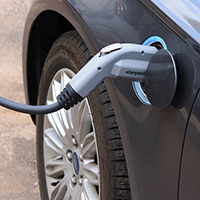
Zapping the Electric Car Tax Credit
View the page for this story
If enacted, a House Republican tax plan would end the $7500 electric vehicle tax credit, a program that has spurred a boom in EV model sales. Union of Concerned Scientist policy analyst Joshua Goldman discusses the subsidy with Host Steve Curwood and what this could mean for the electric car market. (05:20)
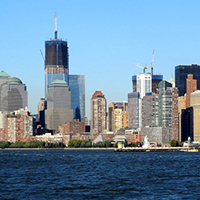
The Antarctic & New York City Floods
View the page for this story
Melting ice around the globe is fueling rising oceans and coastal flooding with differing impacts . One new study suggests that Antarctic ice melt would raise sea levels along the US East coast where the land is also sinking, thereby making catastrophic storm surges and flooding much more common the New York City region. UMass glaciologist Robert DeConto details the study with Living on Earth’s Jaime Kaiser. (05:39)
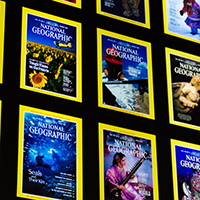
Nat Geo’s New Exploration of People, Places & Planet
View the page for this story
For over a century, National Geographic Magazine has given readers a window into distant corners of the world and revealed unexpected treasures just around the corner. The nonprofit arm of Nat Geo -- the National Geographic Society -- is developing new ways to support people, wildlife and the planet and educate those who study it and can protect it. Host Steve Curwood discussed the Society’s new aims and direction with its President, Gary Knell. (09:58)
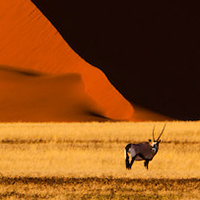
The Earth Is My Witness
View the page for this story
The duty of any photojournalist who documents the natural world must be to conserve and protect it, while reflecting it with a creative and sympathetic eye, notes photographer Art Wolfe. After forty years of traveling the world and capturing natural wonders he has published a visually stunning book, The Earth is My Witness, which features an expansive and beautiful photo collection that documents climate change and the world’s most threatened traditional cultures. Art Wolfe joins host Steve Curwood to shine a light on the power of pictures and how they speak to us. (14:19)
Show Credits and Funders
Show Transcript
HOST: Steve Curwood
GUESTS: Robert DeConto, Edward McGinnis, Joshua Goldman, Gary Knell, Art Wolfe
REPORTERS: Jaime Kaiser
[THEME]
CURWOOD: From Public Radio International, this is Living on Earth.
[THEME]
CURWOOD: I'm Steve Curwood. At the UN Climate meeting, the US promotes carbon free atomic power as part of an “all of the above” energy strategy.
MCGINNIS: The nuclear sector in the United States avoids over 600 million metric tons of carbon a year, so the nuclear fleet globally is a key element to our future clean energy needs.
CURWOOD: Clean energy takes a hit in the GOP house tax plan. It dumps the subsidy for electric vehicles at a cost to local economies.
GOLDMAN: For every fifty dollars you spend on gasoline, two-thirds of that money goes directly to the oil company. Electric vehicles divert fuel spending to local utility providers that have a more vested interest in your local neighborhood compared to a giant oil company.
CURWOOD: That and more, this week on Living on Earth. Stick around.
[NEWSBREAK MUSIC: Boards Of Canada “Zoetrope” from “In A Beautiful Place Out In The Country”, Warp Records 2000]
[THEME]
US Hails Atomic Power At Climate COP23

A nuclear power plant and wind turbines work side-by-side in Drôme, France. (Photo: Jeanne Menjoulet, Flickr CC BY 2.0)
CURWOOD: From PRI, and the Jennifer and Ted Stanley Studios at the University of Massachusetts Boston, this is Living on Earth. I’m Steve Curwood.
Now that Syria has signed on to the Paris Climate Agreement, all nations are aboard, with only the US looking to jump ship. Even so, the US is still active in the UN Climate treaty sessions, and at this year’s meeting at Bonn it’s promoting an “all of the above” energy strategy, including carbon-free power systems that constantly pump out electricity, whatever the weather or time of day. That technology, of course, is nuclear, which today lights nearly every home in France and about a fifth of homes in America.
Of course atomic energy is not popular in many quarters because of costs, accidents, and controversies over waste. But the Trump administration is telling climate delegates that nuclear, especially advanced small reactors, can provide safe, secure and cost-effective base-load power that can integrate solar and wind in systems that emit zero carbon. Here to explain is Edward McGinnis, the Acting Assistant US Secretary of Energy for nuclear power.
MGGINNIS: I can tell you that nuclear energy is a key element of a clean agenda. Nuclear energy represents, for example, in the United States the single largest clean generating source of electricity. Sixty percent of all of our clean electricity generation is from nuclear power. The nuclear sector in the United States avoids over 600 million metric tons of carbon a year because of those plants operating. So, the nuclear fleet in the United States, the nuclear fleet globally, is a key element to our future clean energy needs.
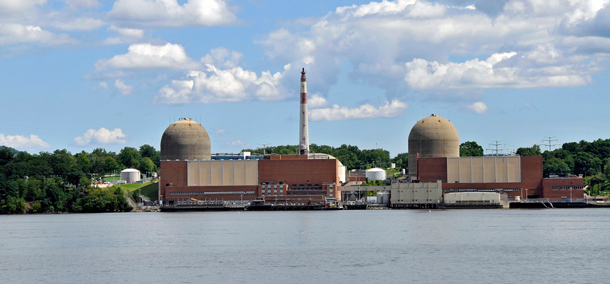
Indian Point Nuclear Power Plant is among the latest old, 1970s-era nuclear power plants to be slated for retirement in the next few years. (Photo: Tony Fischer, Flickr CC BY 2.0)
CURWOOD: What's the message that the United States delegation is giving at the climate summit in Bonn?
MGGINNIS: Well, let me just step back and say what the message we're giving to not only the American citizens but our global partners and others around the world, and that is this administration has an all of the above policy and strategy for energy, and we want to see, and we do prioritize, having the cleanest portfolio possible, whether it's clean nuclear, whether it's renewables. We strongly support wind, we strongly support solar. We also strongly support clean coal. So, we believe that an energy mix that is robust and competitive, where we remove as much as possible government barriers and provide a business-friendly environment, is the way to go. I would also say, when you talk about the global stage, it's important to remind Americans that we have led and we continue to lead in the reduction of carbon. In fact, we are the world's leader in reducing carbon by any country in the world in the past 10 years, and we're proud of that and we're going to continue to support that.
CURWOOD: Now Ed, I'd imagine that a number of people listening to us right now are skeptical. In fact, they might even think that we're nuts to be talking about nuclear power their, their view is the stuff that you use for nuclear power you can make weapons out of. We haven't solved the waste problem. In fact, we have international tension with other countries because of nuclear fuel issues. How do you respond to that kind of skepticism?
MGGINNIS: Nuclear energy has been demonstrated since the ’50s as being able to be used in a peaceful secure way. I have no doubt that the nuclear industry will be around in the future with or without US leadership and I want to be with US leadership. The best way to answer those critics as to what we should do to ensure that it is being used for peaceful purposes is to take the country that has bar none the highest commitment on nonproliferation, bar none the highest level of safety of any other market in the world - That's the United States - to have us be in a leadership role. It's our leadership that will be a key, key aspect to ensuring that nuclear energy continues to be used by the vast majority of the countries - the thirty countries that have nuclear - to use it peacefully.
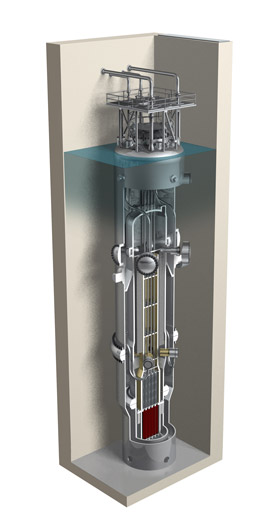
A single Small Modular Reactor (SRM) module design, as conceived by NuScale Power, which is working with the Department of Energy to bring its advanced reactor system concept into commercial use by 2026. (Photo: courtesy of NuScale Power)
CURWOOD: And how does the US nuclear program compare to our competitors? I'm thinking particularly of China, which is, I think, the world's fastest expanding nuclear power producer, and what in your view needs to be done to secure America's competitive advantage?
MGGINNIS: That's a great point. The nuclear sector is a highly competitive sector globally. Korea won one of the biggest nuclear deals in recent memory, and that was back a number of years ago in the UAE. When they won that, it was described as a $20 to $30 billion dollar deal. These are big, big deals. When you're supplying a reactor and fuel to a country, and a reactor is going to operate for maybe 60 years, and you're almost talking about a 100-year relationship, and so it's not only jobs that China, Russia, and others who are major competitive suppliers, it's not just the economic benefit, it's the strategic benefit that is gained when they win these contracts.
So, certainly we are very focused on maintaining US global commercial nuclear leadership. Our competitors are almost all state-owned corporations. The United States government therefore, we do everything we can to support in an advocacy role our American companies to be able to compete effectively with these large, state-owned corporations. I have no doubt that we can compete and win because we have products, and we have technologies, and we have business approaches that are unmatched by any of the state-owned corporations. I have no doubt. But the challenge is to give an even, level playing field for our companies to effectively compete and win.
CURWOOD: Many of the nuclear power reactors around America and indeed the world today are based on pretty old technology. What's coming in terms of advanced technology that you think would increase the confidence of the public that it can be safe and cost effective?
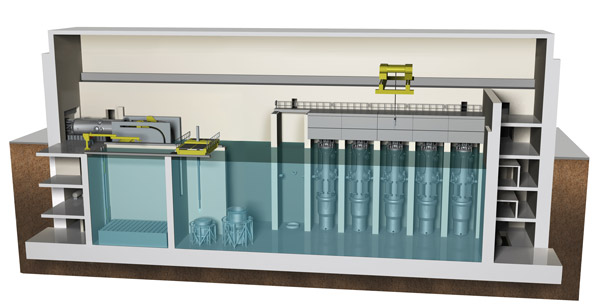
A design of an SRM reactor building showing multiple modules. (Photo: courtesy of NuScale Power)
MGGINNIS: We have advanced reactors including advanced small modular reactors. In particular, one that is already working its way through the Nuclear Regulatory Commission’s design licensing process, the first, first ever advanced small modular reactor that has been accepted and being reviewed by the NRC with a timeline of 2026 in the United States to be commercially operated. And this particular advanced reactor and a number of others bring some key game changers. One is passively safe, walk-away reactors. What I mean by that is if you had a complete loss of power offsite power these reactors automatically shut down without any human intervention, without any motors or pumps. They have step-change improvements in efficiency, and also they have the potential significantly for a great deal of different applications, not just power generation but de-salinization for petrochemical.
There's one very exciting approach we're looking at now. We call it the hybrid approach, where we are looking at small modular reactors paired up with a solar plant, paired up with a wind turbine plant, and that is a real potential winning combination, base-load nuclear power clean with a renewable plant like solar or wind. And we're actively looking with our national laboratories at that hybrid approach. So, we have some real game changing technologies that, I think, change the landscape and even, frankly, perception of nuclear reactors.
CURWOOD: What would be the advantage of what you call a hybrid approach? Folks listening to us might say, “Hey, what about solar and wind? They're cheap and they're quick.”
MGGINNIS: Sure, well as much as I love solar and wind, the problem is at night you have no sun, you're not going to get power from the solar plant. When the wind is not blowing, you're not going to get power from the wind turbine plants. From a resiliency perspective nuclear power is key. Secretary Perry has launched a very, very important national discussion because we need to make sure that we have a resilient electricity grid to ensure our citizens always have access to power. Not just when things are going well, but dead of winter or in the middle of the summer, whether it's a polar vortex or a hurricane coming, we want to make sure that we have base-load power. Renewables, intermittent sources as we described, will not be enough.
CURWOOD: How do we deal with the waste problem with nuclear power?
MGGINNIS: I can tell you how we need to deal with it. We need to deal with it as this administration has done, and that is we need to stop kicking the can. We have to absolutely take responsibility. It's our moral obligation to find once and for all a path forward for dispositioning that spent nuclear fuel that we have already committed to doing. So, we submitted in the 2018 budget a substantial request for Congress to appropriate, that would allow us to now promptly resume the licensing for the Yucca Mountain application in the NRC as well as concurrently move out on a robust interim storage. So, Secretary Perry, I strongly, the administration, feels very much it is our obligation we need to do this on behalf of the American people.
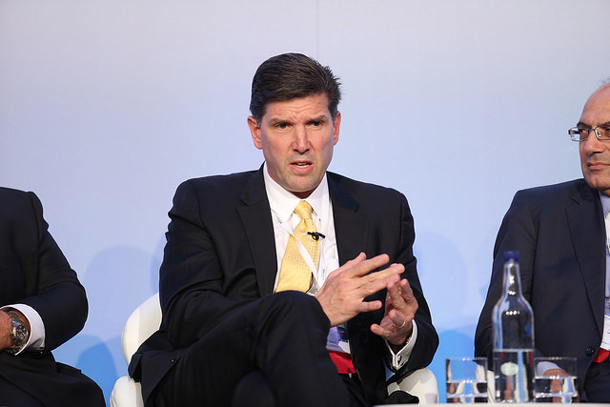
Edward McGinnis is Acting Assistant Secretary for Nuclear Energy at the US Department of Energy. (Photo: World Nuclear Association, Flickr CC BY-ND 2.0)
CURWOOD: The big challenge for nuclear power has been financing. Wall Street hasn't seemed terribly interested, and taxpayers have had to guarantee loans. And there's a concern that the market doesn't seem to like it. Your response?
MGGINNIS: Well, first and foremost, it's almost a chicken and the egg. If a market, as we've seen certainly in the past number of years, has a government policy that is not clear and not consistent on nuclear energy, that sends a chilling effect on potential investors. If you have a market that is favoring one source, such as renewables, over another and creating negative pricing, that scares away investors.
The advanced small modular reactors, in my view, in Secretary Perry's view, is a potential game changer. A couple of reasons why: one is financing. A typical large reactor of the type we have in the United States now and around the world…Basically you have a choice and around the world of large or larger reactors. One reactor will cost you on average $8 billion dollars before financing, and most like to order two units, so we're talking about $14 billion before financing.
Most utilities do not have much larger of a market cap in that entire price tag, and so small modular reactors, they're going to come in let's say 50 megawatts each and it can go up to 12, you know, a 12 pack for 50 megawatts electric each. The ability to secure $750 million or a billion dollars to get that initial bite at the apple, to build that initial capacity, the ability to then start selling that electricity generating the revenue to then take the second bite to finance the second unit on and on, that's a game changer.
CURWOOD: Edward McGinnis is the Acting Assistant Secretary of Energy for Nuclear Power at the Department of Energy. Thank you so much, Sir, for taking the time today.
MGGINNIS: Thank you very much it's my pleasure.
Related links:
- NYTimes: “Trump Team to Promote Fossil Fuels and Nuclear Power at Bonn Climate Talks”
- NuScale Power’s SMR (Small Modular Reactor) design is currently under Nuclear Regulatory Commission review
- Department of Energy’s Office of Nuclear Energy
- The UN climate conference in Bonn, COP 23
- About Edward McGinnis
[MUSIC: Nicholas Yee/Adam Caulfield/Katherine Pernal, “Stranger Things” on Cello Soundtracks, by Nicholas Yee, released by Nicholas Yee]
CURWOOD: Coming up, electric cars get zapped in a Republican tax overhaul plan. That’s just ahead here on Living on Earth.
ANNOUNCER: Support for Living on Earth comes from the Gordon and Betty Moore Foundation, and from a friend of Sailors for the Sea, working with boaters to restore ocean health.
[CUTAWAY MUSIC: Art Blakey, “I’ve Got My Love To Keep Me Warm” on Art Blakely – Drums Around the Corner, Irving Berlin, Blue Note Records]
Zapping the Electric Car Tax Credit
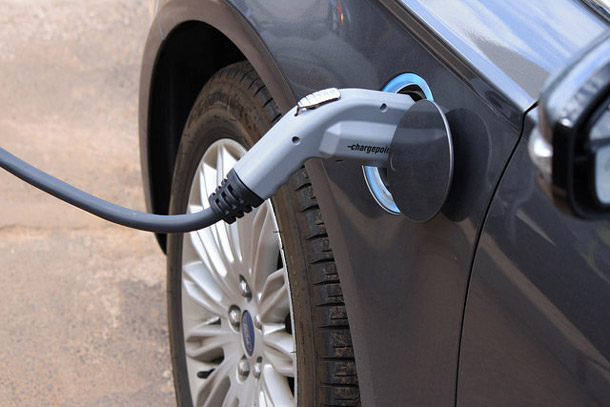
Electric vehicles generally outperform gasoline cars in terms of equivalent mileage, even when the electricity comes from grids with high numbers of coal-powered plants. (Photo: Noya Fields, Flickr CC BY-SA 2.0)
CURWOOD: It’s Living on Earth, and I’m Steve Curwood.
While a string of Democratic and center-left victories at the ballot box November 7th may have dimmed the prospects of a tax overhaul proposed by US House Republicans, the battle is far from over. And one proposed provision that is sparking opposition would eliminate the $7,500 federal tax credit for electric vehicles like the Tesla Model 3 and the Chevy Bolt.
Another clause would also shrink wind tax credits and solar tax incentives, while China has said it will boost its renewable energy spending over the next two decades to more than $360 billion. US solar and wind subsidies have gone up and down over the years, but eliminating the tax credit for electric cars could jolt the EV business and set it back.
Joshua Goldman is a Senior Analyst for the Clean Vehicles Program with the Union of Concerned Scientists, and he’s on the line now from Washington. Welcome to Living on Earth.
GOLDMAN: Thanks, Steve. Thanks so much for having me.
CURWOOD: So, talk to me about the $7,500 dollar federal tax credit for electric vehicles. When was this credit first put in place, and what was the economy like for electric vehicles before then?
GOLDMAN: Well, the tax credit arguably is the single most important federal policy we have on the books that is supporting the electric vehicle market. Since this credit was enacted '08, the electric vehicle market has grown from just two models to over 30 models that people can choose from in dealerships across the country, and we're seeing multiple brands now get involved in the EV market, so it's not just Nissan and Chevy, it's also GM and BMW and VW and Kia and of course Tesla, and a suite of other automakers are now beginning to offer electric vehicles at different price points that can appeal to different consumers, and so the tax credit has really spurred a lot of that innovation, and it has allowed the US to become a leader in electric vehicle deployment and sales, but that leadership is really in jeopardy now that the tax credit is on the chopping block in the House tax plan.
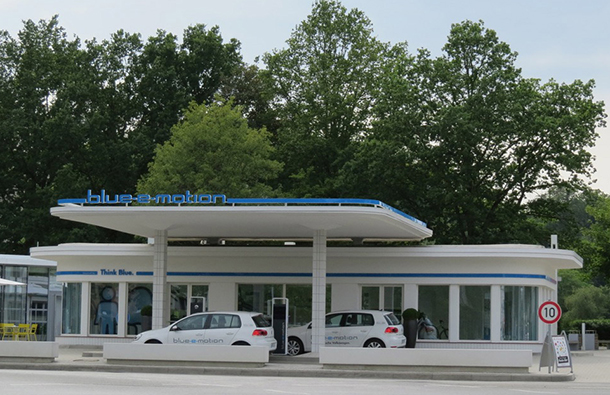
A filling station with “juice” for electric cars. (Photo: PapJeff, Flickr CC BY-NC 2.0)
CURWOOD: So, what are economists and experts predicting will happen if what the House is proposing actually becomes law, and this incentive in America for electric cars goes away?
GOLDMAN: Sure. I mean that's hard to predict exactly what's going to happen. There still is a lot of excitement around electric vehicles but it's pretty clear that the removal of federal support for electric vehicles will impact EV sales. I mean, one of the reasons that EVs are still only gaining market acceptance now is that they still are slightly more expensive than a comparable gasoline vehicle. And so the tax credit really helps bridge that price gap. One interesting example for what can happen to EV sales can be found in Georgia which also had a state tax credit for electric vehicles on top of the federal tax credit, and when the Georgia legislature removed the $5,000 dollars state tax credit for electric vehicles, electric vehicle sales dropped an estimated 90 percent in the state.
CURWOOD: So, now, what statistics do you have on the carbon emission benefits of electric vehicles?
GOLDMAN: UCS looked at that question in depth, and the emissions of an electric vehicle vary across the country, and they depend on where you live because they depend on your electricity mix. So, if you live in an area of the country that has a relatively dirty electricity grid, then the emissions profile of an EV is going to be different than if you lived in an area of the country that has a relatively clean electricity grid.
So, UCS examined all the different electricity grids across the country, and we found that no matter where you live in the country an electric vehicle is going to provide better emissions performance than a comparable gasoline vehicle. So, if you live in a place like upstate New York which has a lot of hydro power, we found that driving an electric vehicle in that region produces the emissions equivalent of a hypothetical gasoline vehicle that gets 135 miles to the gallon. Now, if you live in the Pacific Northwest, that equivalent is 94 miles per gallon, if you live in Texas it's 52 miles per gallon, and it sort of varies across the country.
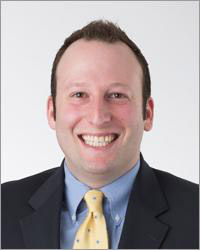
Joshua Goldman is a Senior Analyst with the Union of Concerned Scientists. (Photo: Union of Concerned Scientists)
CURWOOD: This proposed tax bill is a massive overhaul of the federal tax structure and many elements of it, but what's the rationale of the writers of this bill for getting rid of the tax credits for electric cars?
GOLDMAN: Well, I certainly didn't write the bill, but I assume that it that they are eliminating the electric vehicle tax credit as a cost-saving measure, but that doesn't make a lot of sense when you look at how much this credit has actually cost the American public and the benefits that electric vehicles provide for American consumers. So, for example, in fiscal year 2015, the EV tax credit cost America $580 million dollars. OK? Now by comparison the tax credits that we give to the fossil fuel industry cost us $4.7 billion dollars every year, so if you look at how much we're spending on electric vehicles versus how much we're responding subsidizing the oil and gas industry, it's not even close.
CURWOOD: Joshua Goldman is a Senior Policy and Legal Analyst for the Union of Concerned Scientists. Thanks so much for taking the time with us today.
GOLDMAN: Thanks so much. This was great.
Related links:
- More on electric vehicles
- Federal Tax Credit information
- NYTimes: “Six Charts That Help Explain the Republican Tax Plan”
- Joshua Goldman UCS Profile
The Antarctic & New York City Floods
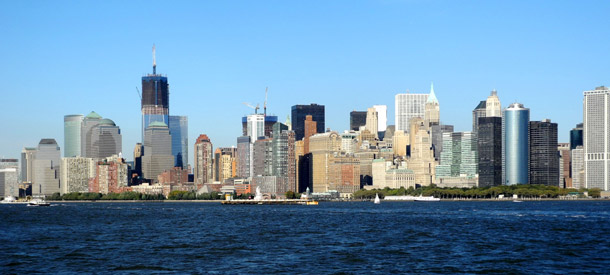
Much of New York City is only a few feet above sea level, making it vulnerable to flooding like the surge from 2012’s Superstorm Sandy. (Photo: Ilana, Flickr CC BY-ND 2.0)
CURWOOD: The late Speaker of the US House Tip O’Neill was famous for saying, "All politics is local", and he could have been talking about the weather. As the global climate system is warmed and disrupted, local weather can change in diverse ways. Consider the region around New York City, for example, where Superstorm Sandy thrashed the coast in 2012 with a destructive storm surge. Such a storm would have occurred about once every 500 years back in 1800. But the east coast of the US is sinking, and combined with rising sea levels from melting ice in the Antarctic, the occurrence of catastrophic surges in the New York area is predicted to rise.
UMass glaciologist Robert DeConto is one of the authors of a new study on this, and he spoke with Living on Earth’s Jaime Kaiser.
KAISER: So, Rob DeConto, you're part of a team that produced this new research on the effects of Antarctic ice melt on flood risk in New York City. So, what are the fundamental conclusions that this new study makes about sea level rise, and what it means for New York City?
DECONTO: I think it was a little bit of a surprising result, in that it's expected that as the world continues to warm over the century, that there are storms will become bigger and badder and more intense. The modeling that was done suggests that, indeed, it looks like the stronger storms will get stronger, but what they found also was that the storm tracks where these storms go, end up being a little bit further offshore and away from the coastline. So, those two things sort of balance each other out. So, there wasn't a really big increased impact on New York from the tropical cyclones themselves. But then when we consider those tropical cyclones in the future on top of the fact that the oceans are going to be rising - So the background sea levels are going to be going up - then we found that there is a really big impact on New York.

Some impacts of Hurricane Sandy on the West Side of Manhattan in 2012. (Photo: Sarah Ackerman, Flickr CC BY 2.0)
KAISER: So, talk a little bit more about why these background sea levels are going to go up in the future.
DECONTO: Well, I think the really big question is what the big ice sheets that sit on Greenland in Antarctica might do in the future. There is a lot of ice locked up in those ice sheets, enough to raise sea level by, you know, on the order of 65 meters or so. Really, in terms of the long term future, the big questions are what those really big ice sheets are going to do because that's when the biggest potential for sea level rise is.
KAISER: You did a whole other study about Antarctic melt that came out last year, and a lot of that data was then applied to this study. Is that correct?
DECONTO: It is. So, the Antarctic ice sheet has almost 10 times more ice locked up in it than Greenland, and our study last year suggested that Antarctica might be more vulnerable to warming in the future than we used to think. And so, in this New York study, they looked at older estimates, and then they took those estimates and they added the contributions to sea level rise from Antarctica that we published last year, and that drove the impacts on New York upwards.
KAISER: How much storm surge would we be looking at?
DECONTO: They're looking at a fixed storm surge height of two and a quarter meters. So, what's that? That's about a little more than six feet, and they look at how that might evolve in terms of how often that might happen. And what they found was that at the beginning of the last century that it's about one in every 500 years, and then that same sort of level storm surge starts to happen about every 25 years today, and then as you go out into the future, by the time you get to the middle of this century, what used to be a once in every 500 year event 100 years ago, that's a 25 year event today becomes a once in every five year event. By the time you get to about the year 2100, it's almost always at that sea level. So, what is today a big storm surge event like a Hurricane Sandy, just the background sea level is that high in the year 2100 in these more extreme estimates. That doesn't mean that, to say that that's what's really going to happen, but at the more extreme end there's some pretty serious implications.
KAISER: Now, this study focuses on New York, but how can the projections made in this study be applied to predictions for other cities?
DECONTO: You know, they found this really interesting result, where even though the intensity of future storms that could drive storm surge increases, there's a shift in the storm track that compensates for that. That's pretty good news for New York, but that could be bad news for someplace else, maybe further up the coast, Boston, for example or Halifax, Nova Scotia.
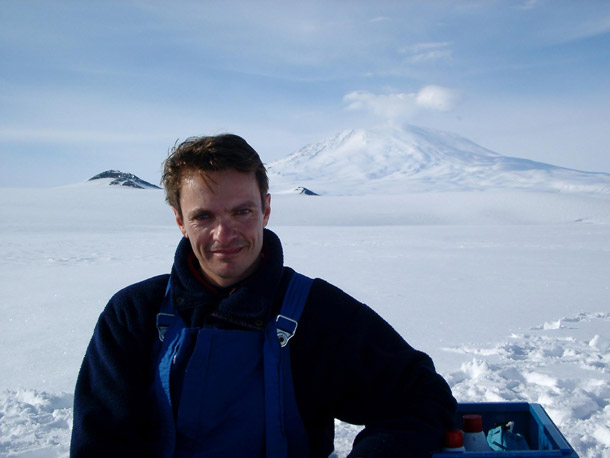
Robert DeConto is a Glaciologist at the University of Massachusetts, Amherst. (Photo: courtesy of Robert DeConto)
KAISER: So, as a glaciologist, how worried are you about this?
DECONTO: You know, I'm more optimistic, I think, than you might think based on you know the sorts of numbers that are coming out of our model, and again that's because we're still finding that in these more aggressive mitigation scenarios, where we really get our global act together and make a concerted effort to reduce emissions, we're finding a much reduced risk of these sorts of really extreme sea levels. Really, at the end of the day the biggest uncertainty is actually not with the models or the understanding of the physics of the system, but it's what we're going to do in terms of society and our future greenhouse gas emissions. So, at the end of the day I'm optimistic.
CURWOOD: Rob DeConto is a Glaciologist at the University of Massachusetts at Amherst. He spoke with Living on Earth’s Jaime Kaiser.
Related links:
- The full study in PNAS: “Impact of climate change on New York City’s coastal flood hazard: Increasing flood heights from the preindustrial to 2300 CE”
- Hurricane Sandy devastated parts of New York City five years ago
- New York City Major Bill de Blasio’s Climate Plan
[MUSIC: John Williams, “The Reunion” on A.I. – Artificial Intelligence soundtrack, Warner Bros.]
Nat Geo’s New Exploration of People, Places & Planet
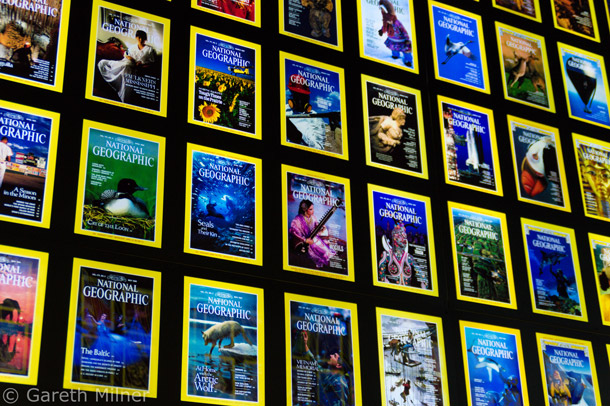
National Geographic magazine covers at their headquarters in Washington D.C. (Photo: mrgarethm, Flickr CC BY 2.0)
CURWOOD: The brilliant yellow border on the cover of the National Geographic magazine is iconic, and years ago the National Geographic Society offered a rare window for Westerners into exotic, distant lands and peoples. The advent of television, and cheaper travel eroded that vital role, but the magazine is still going strong, creating new directions and partnerships, and a new way of doing business.
While the media arm of Nat Geo is now owned by Twenty-First Century Fox, the non-profit Society is using its royalties from TV and publishing to forge a new mission aimed at empowering people who can tell the story of the human journey, wildlife and wild places, and our changing planet.
And it’s being led by Gary Knell, who spent two decades in leadership at Sesame Workshop and also served as CEO of NPR. Gary, welcome to Living on Earth.
KNELL: Steve, great to be here. Thank you.
CURWOOD: So, let's talk about Nat Geo. Now this is an organization that you've actually been involved with for a long time over your life.
KNELL: Yes, I was first involved in the education side, and they had set up an education foundation that I was a governor, the first and only time I've been called “governor”. I really believed in the mission of educating kids to be geographically literate, which is, I think, still really important especially in the day and age we live today.
CURWOOD: I know, if you say to a kid, “Quick what's the capital of Wyoming?” sometimes you get a blank stare.
KNELL: Yeah, I think it's that. It's also more. It's really about teaching kids how the world works that Flint, Michigan, was indeed a geography lesson, and water doesn't comes from turning a knob in your kitchen, it comes from some water source that someone in Detroit and Flint made some bad decisions about.
CURWOOD: So, let's go back maybe 130 years or so. So National Geographic, which is such a powerful brand, everybody knows Nat Geo, and you go into, you know, a zillion attics or basements around the country, and you'll find stacks of the magazine because they're just too delicious to throw away.
KNELL: There is something about National Geographic. Someone described it as Google before there was Google. It really, though, Steve, was a chronicling of planet Earth and all of its inhabitants, both human and non-human.
CURWOOD: So, if you look at the National Geographic founders, it's a bunch of men with a big handlebar mustaches and a star. I think Alexander Graham Bell was important in the organization.
KNELL: They would have been making lattes at some hipster coffee shop today, I think.
CURWOOD: [LAUGHS] And then, things have changed. Probably, say, 15 years ago, there was an editor of the magazine who started talking about climate change in a rather emphatic way, and now you continue to move forward with change. So, tell me, what is the new National Geographic, and what is the deal with Twenty-First Century Fox?
KNELL: Yes, so the Geographic has been a sustainable enterprise as a nonprofit for, as you mentioned, almost 130 years, and one of the reasons why it is still around and why a lot of others are not around is that my predecessors were very good and entrepreneurial about changing with the times and adopting the media that was then of interest that people would want to adjust to. So, even the original editors of the magazine, going back to the first Grosvenor, Gilbert Grosvenor, put photos in the magazine which was revolutionary of the time. Two members of the board quit because they thought it would dumb down National Geographic, which tells you not always to listen to your board of directors -- I'll get in trouble for that, but -- so, what it evolved over the years is a integrated set of media or somewhat of a disaggregated set of media properties that were as the television networks which were a joint venture with Twenty-First Century Fox going back almost 20 years, then the print magazine and the digital assets. And what we did a couple years ago was put them together in the joint venture so that they could be integrated. They could cross promote each other and scale up around the world, so now we're reaching over 700 million people around the world.
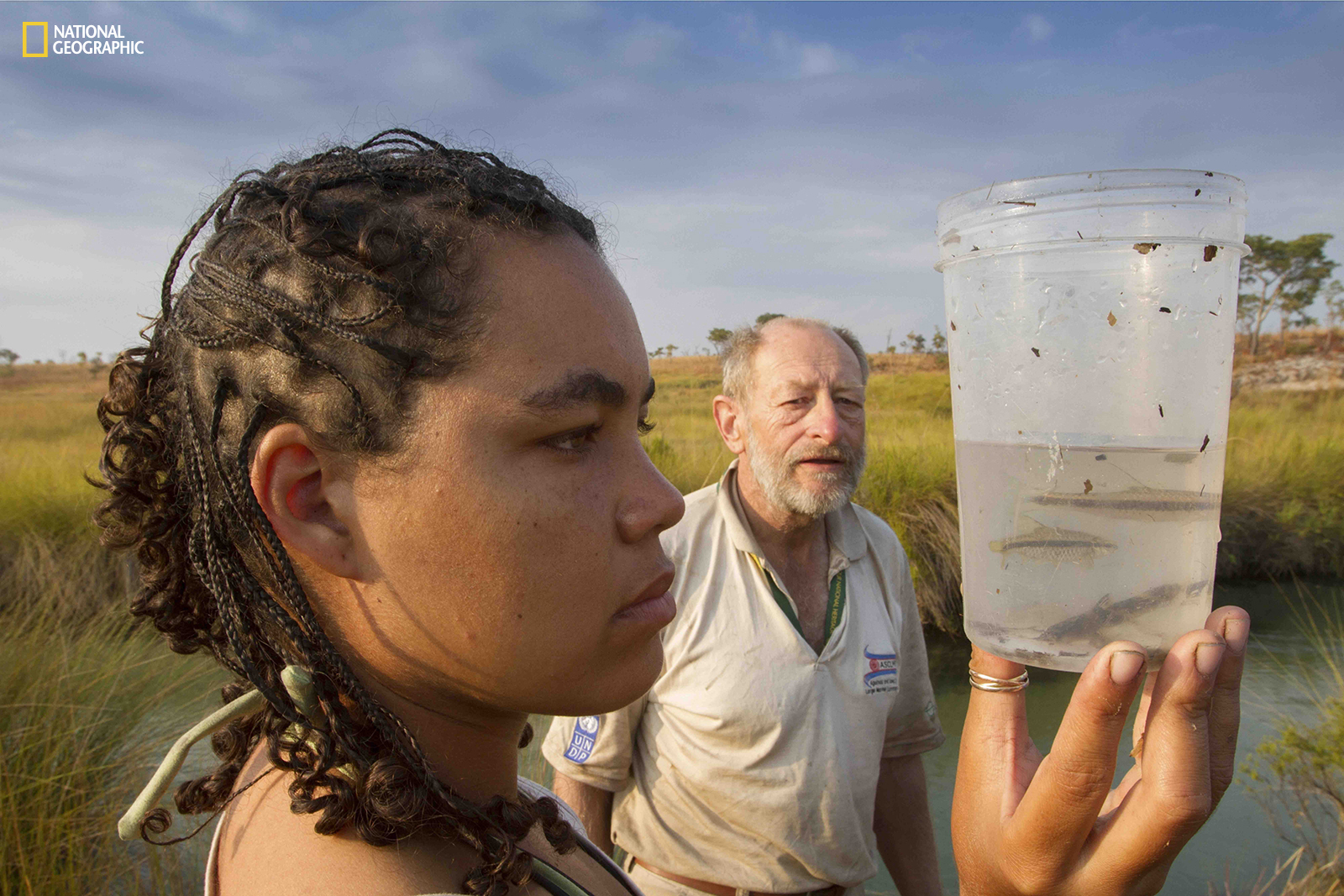
A scene from the Okavango Wilderness Project -- one of the many social projects initiated by the National Geographic Society. (Photo: James Kydd)
CURWOOD: And what about your financial model?
KNELL: We've set up a unique model where the media joint venture spins off revenues for the Geographic. We get 27 percent of the profits every year of the media joint venture that we have, and also we have now a $1.2 billion dollar endowment, so we are able to do a drawdown like a university of some minor percentage of that every year. So, we have a working capital basis. It is a very unique business model for nonprofits. I've been able to leverage what many of my predecessors built in the past.
CURWOOD: So, now Nat Geo is split into a media company which has a commercial purpose, and, and you are the CEO of the nonprofit side of the National Geographic Society. So, where you and your colleagues taking the organization on this nonprofit side?
KNELL: That is really exciting, Steve. We are focusing on human and physical geography, and we divide that into three “lenses”: The changing planet which covers things like climate change and ocean health; wildlife and the wild places they occupy; and what we call the human journey. And in those lenses we're now funding innovators in early careers, in mid-careers, people who are students and others in the field, who are scientists and conservationists. They're photographers and their teachers. They're geographers and technologists, people who are using their skills to focus and help move the needle on these really critical issues that I think the listeners on the show care about.
And then we're also doing education work. So, we're going to be focused very specifically on middle schoolers. We think that’s when kids are really getting a world view, sixth, seventh, eighth graders. We're going to do a lot of work in the inner cities, and in fact, are test piloting this program this year with the DC public schools, where we are based, but we'll be playing those out around the country in the next couple of years to really focus on teaching geographical competency to middle schoolers. We’re really excited about that.
CURWOOD: Climate change. So, you know some of us would say that if we don't get this climate change thing right, nothing else really will matter. What activities is the National Geographic Society doing about the question of climate change?
KNELL: Fifteen years ago we had a cover story called Global Warning, which is really a play on words, of course, and we've been trying to ring this bell pretty loud in our public offerings. Climate change is something, Steve, that covers all of the work that we're in, and it's a bit of an umbrella. Whether it's the brilliant work of someone like Brian Skerry in Boston who's an underwater photographer, he will tell you about the impacts of climate change on wildlife in the ocean and coral reefs, and we are working on marine sanctuaries in our Pristine Seas program where we have work to preserve over five million square kilometers of the ocean. But a lot of these are being impacted by a warming climate, so through our explorers, through our storytellers, we are trying to make this much more of a engagement with the public that tries to get away a little bit from the divisive rhetoric that we live in in Washington.
You know, our office is four blocks from the White House. No matter who's sitting in that house somehow these issues have become quite divisive and toxic. It should be something that all Americans ought to be engaged around, and what we should be questioning what we should do about it, not whether we should do anything about it.
CURWOOD: So, National Geographic has such a huge impact. How can you affect this division that seems to have us having trouble making progress in the area of dealing with climate disruption?
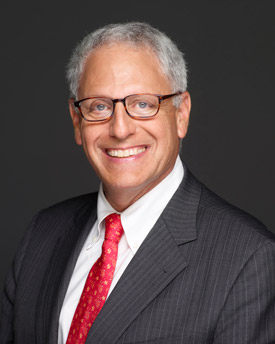
Gary Knell is the President and CEO of the National Geographic Society. (Photo: Mark Thiessen)
KNELL: We have been convening different audiences in Washington, actually across the political divide. We have ways of engaging with skeptics that other environmental organizations are unable to do, and the other thing I would say, Steve, is, you know, as a nonprofit because we are not really totally dependent on fundraising we don't have to demonize individuals or groups that some folks in different movements have to do to raise money, which is great because you're able to raise money, but the flip side is you're never going to get a meeting with the individuals you've attacked. So, what we're trying to do is leverage our nonpartisan approach, as challenging as that may be in a highly partisan political environment, in a media environment, to educate members and their staffs about critical issues and I think we're making some progress there.
CURWOOD: How critical is this mission for you?
KNELL: Very. Look, I've been involved in educational media for over 40 years and I view now a world that is going to have nine-and-half billion people by the year 2050, a billion more in Africa alone. Nigeria will have more people than the United States in 2050. We're going through monumental population shifts. How are we possibly going to educate all these folks around the world, provide energy for them in a growing middle class, so to speak, house them and feed them without burning up everything around the planet? This is an existential question, and I don't care if you're a Democrat or a hard-rock conservative. When I pose that question to folks they look at me and they go, “That's the right question”.
CURWOOD: Gary Knell is President of the National Geographic Society. Thanks so much for taking the time with me today.
KNELL: Great to be here, Steve. Thank you.
Related links:
- National Geographic website
- More on National Geographic Society President Gary Knell
[MUSIC: 2Cellos/Zucchero, “Il Libro Dell’amore” on In2Ition, composed by Magnetic Zeros/Peter Gabriel, Sony Masterworks]
CURWOOD: Coming up...pleasing the eye to power the conservation ethic. That’s just ahead here on Living on Earth. Stay tuned.
ANNOUNCER: Funding for Living on Earth comes from you our listeners, and United Technologies - combining passion for science with engineering to create solutions designed for sustainability in aerospace, building industries and food refrigeration. UTC companies such as Otis, Carrier, Pratt & Whitney and UTC Aerospace Systems are helping to move the world forward. You can learn more about United Technologies by tuning in to the Race to 9 Billion podcast, hosted by UTC’s Chief Sustainability Officer. Listen at raceto9billion.com. That’s raceto9billion.com. This is PRI, Public Radio International.
[CUTAWAY MUSIC: Charlie Parker, “Night In Tunisia,” on Now’s the Time, by Dizzy Gillespie, Membran Media GmbH]
The Earth Is My Witness

A gemsbok idles in Namib-Naukluft National Park in Namibia. Wolfe’s most recent photography collection is structured according to biome, with chapters highlighting mountains, oceans, and deserts, among others. (Photo: Courtesy of Art Wolfe)
CURWOOD: It’s Living on Earth, I’m Steve Curwood.
A picture, they say, is worth a 1,000 words, though in radio we always hope our words help your mind create better pictures than any you might actually see on a page. But the game changes when the image is art, and art, dare I say fine art is the essence of the gorgeous book “Earth Is My Witness”. It is the result of 40 years of travelling the globe, camera in hand, by artist-turned-photographer Art Wolfe. He’s on the line now from Seattle. Art, welcome to Living on Earth.
WOLFE: Thank you. I’m happy to be here.
CURWOOD: So, here you have this absolutely stunning book loaded with photographs and from your story that's in the book, I gather you started with a [Kodak] Brownie camera as a kid?
WOLFE: Brownie Fiesta, that was my first camera. [LAUGHS]
CURWOOD: [LAUGHS] And your family, I guess your folks were artists, making their living with art, and you thought you would be an artist as well I gather.
WOLFE: You know that's exactly what it was. As a young man I had two great loves, going out into the forest with a little bird book, mammal book, tree book, and I was a naturalist without even knowing the word ‘naturalist’, and I studied them and I memorized them, and they've stuck with me all these years. But the other thing that I loved to do was to draw and paint, and my mother took a correspondence course in drawing and painting, and I had my little easel, and I’m right there watching her, and I must have been around five, six, and seven during that period of time. So, it was ingrained early on, both art and nature.
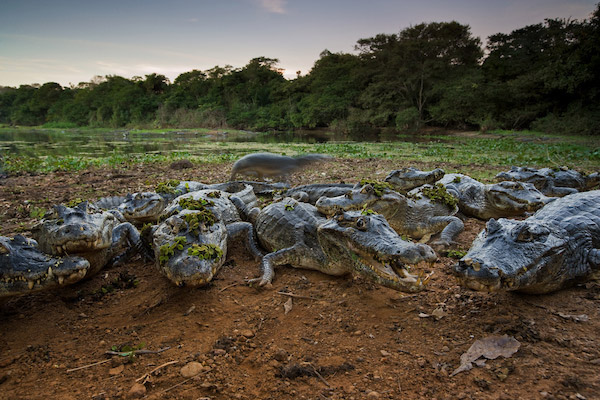
Uruguayan caiman emerge from a wetland in Brazil’s Pantanal. As Wolfe says, these five-foot-long reptiles are accustomed to humans feeding them, so they aren’t afraid to approach a photographer. (Photo: courtesy of Art Wolfe)
CURWOOD: So, at some point you decide that the pen, the pencil, was maybe a little less effective than what you could do with the camera. Why?
WOLFE: Actually it's a really curious evolution because all through grade school, junior high, high school, and then into college, I always focused on art, and in fact I wound up getting a degree in painting, fine art painting at the University of Washington. But during college years whatever I was learning about composition and esthetics of art I was applying to my burgeoning photography career. So, there was this parallel life, one during the week studying artand Matisse and Jackson Pollock and all the history of art, and on weekends I'd be doing the other great love which was pursuing nature and climbing the mountains, and suddenly the camera became part of the journey, initially just to capture the scenes to show my family and friends where I will gone on weekends. But they responded, and I was responding at the same time, learning composition and painting applied to photos.
CURWOOD: Art, you named your book “Earth Is My Witness”. Why did you pick that title and what does it mean?
WOLFE: It is a excerpt from a Buddhist prayer, and I think what it means is the Earth is watching and always watching what we as humans are doing, and I think it’s very prophetic in today's world.
CURWOOD: What does "Earth Is My Witness" mean to you?
WOLFE: You know, over 40 years as I have traveled, it's hard to pin down the genre of my work. I photograph abstracts in major cities. I photograph indigenous cultures. I photograph wildlife and landscapes. So, virtually everything is of interest to me, and so over a 40 year career, I think “Earth Is My Witness” is a testament to what I've seen and what I've experienced on a global scale that I've just absorbed over the years.
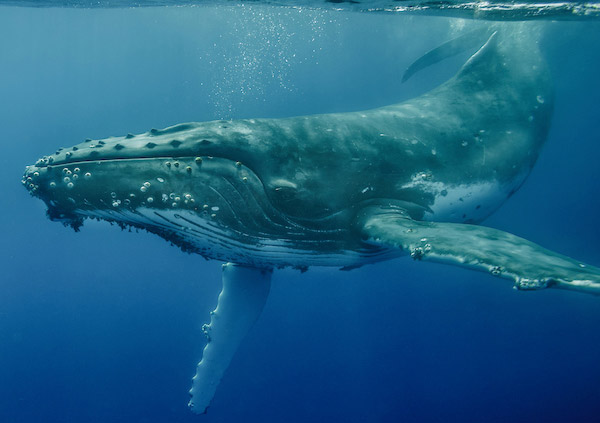
A Humpback whale submerges in the Pacific Ocean, near Tonga. Tonga and the Dominican Republic, Wolfe explains, are the only countries in the world in which it’s legal to snorkel with these massive creatures. (Photo: courtesy of Art Wolfe)
CURWOOD: Art, well, you say you have no particular genre, but I think one of the most exciting things you do is you take color right to the edge of the most saturation that the medium will allow, and it's really a lot of fun.
WOLFE: Well, thank you. I think we have historically used films that were not as rich as what we actually see in the real world. When I'm looking out this window..For instance right now, I've got Japanese maples that are a riot of red. But historically when we would use Kodachrome film it was more of a great palette of reds and greens, and so consequently I don't know that our brains are translating the color as rich as it is. Having said that, now in the age of digital, you have to use a certain amount of contrast and saturation to restore it to the color that it was. I just want the images in the book to be crisp, clean, and vibrant like the paintings I used to do as well.
CURWOOD: How fair is it to say that you find color exciting?
WOLFE: Well, I teach color. You know, I teach a lot of classes around. I love using complementary colors, and I talk about the theory of color and how famous artists like Claude Monet and other people use complementary colors in close juxtaposition to create excitement to their rods and cones in our eyes, and so I use color judiciously. I get up early. I stay out late. I use the light. I often use very subdued color to bring out the saturation and the richness of the environment. I avoid noonday light which makes really high contrast, high key photos, so I'm trying to do the best I can in capturing a subject in the best light and the best color.
CURWOOD: I want to talk to you about journalism versus art. Where do you put your photos along that spectrum?

A lone Gentoo Penguin peers out over the water and melting ice of Antarctica. Art Wolfe considers himself an advocate for conservation and seeks to capture the impacts of climate change in his work. (Photo: courtesy of Art Wolfe)
WOLFE: I think that they encompass both. You know, I love nothing more than to go into a remote village along the Sepik River in New Guinea or into the deserts of Ethiopia or wherever it may be, the hill tribes of Southeast Asia, and capture a tribe and their quality of life before the inevitable creep of Western civilization. So, I want to capture those traditions before they're gone. I purely look at that as a journalistic style and drive, but I'm going to also do it in as eloquent and artistic way I can. I'm not simply aiming the camera at a subject, I'm framing the shot. I'm thinking about the backdrop. I'm trying to capture the subject in a way that has an emotional connection to the audience. If I can't make that emotional connection to the audience, they're going to move on, and so it's all about communicating what inspired me, what I'm seeing, and paying homage to that.
CURWOOD: So, you write in your book at one point that there's this perception that photography is real and whatever you aim the camera at is a pure recording of reality, and you don't agree with that.
WOLFE: It is simply not true. It has never been true. You as a photographer instantly start putting your own slant on a photo, and journalists which have to abide by the most stringent of ethics still have powerful ways of telling their stories, and they may include or exclude things that distract from what they're trying to tell, but they're altering their reality by what they choose to include or not, whether they use a wide angle or whether they use a telephoto lens to compress the scene, they are making choices that changes the actual reality of the situation, and their goal is still making some sort of esthetically strong, graphic image out of the subject.

Children play in a tree in Zanzibar, Tanzania. To get this candid shot, Art Wolfe says, he had to hide and approach cautiously – when the kids saw him, they would smile and pose. (Photo: Courtesy of Art Wolfe)
CURWOOD: You say you became a cultural photographer when you were up on Mount Everest. Tell us that story please.
WOLFE: Yeah, you know, in the '50s I was growing up and in the '60s I was very aware that Tibet, nobody knew what was going on in Tibet. When the offer to came through my friends to join them as expedition photographer, I seized the moment not because I ever grew up with dreams of being up on Mount Everest. I wanted to see Lhasa. I wanted to see what the Tibetan people were like, and so I joined the expedition and spent three months up on the mountain. Went from 16,000 to 25,000 thousand feet to the North Col, I never planned on being a high altitude climber, but North Col is pretty high. Then it was the yak drivers, the villagers that were down valley that were of intrigue to me, and when I first started photographing the cultures that lit a light in me, and I thought, “My God, if I survive this expedition, I'm going to travel as fast and furious as I can,” because we saw the first little tiny black and white TVs in some of the villages outside of Lhasa, and it's like, wow, the light of that TV is analogous to a freight train coming their way.
CURWOOD: Let's talk a bit about your involvement with subjects. At the very beginning of your book you have a spread. It's actually over two big pages of a humpback whale that you photographed in Tonga. What was it like being in the water with this, well, it’s a huge animal?
WOLFE: It is a huge animal. I've spent a lot of time with whales in Southeast Alaska, but I have never been in the water with them, and so I went to Tonga because Tonga, like the Dominican Republic, are the only two countries in the world that permit getting into the water with humpback whales and you're only allowed to snorkel. So, the whale has total decision making as to whether they stick around or not, and it is a really cool feeling to have a whale circle you and see its eye looking straight at you as you're kind of floundering in the water.
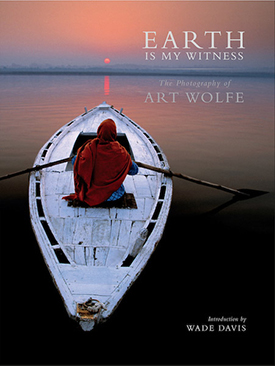
Art Wolfe’s book is titled “Earth is My Witness." (Photo: courtesy of Art Wolfe)
As I said, I'm from Seattle. We don't swim up here, you know, the waters of Puget Sound are cold. So, I'm floundering around in the South Pacific, and a baby humpback whale is circling around its mother. The mother comes over and checks me out. I had no sense of danger. I mean, historically I never have never heard of one injuring a person. But however, in that same shoot their whale has to sort of emerge for a couple of minutes and then it comes up every seven minutes, and when it comes up I'm trying to swim as close as I can to where it would hit the surface to get a better shot. And I guessed a little too effectively, and the whale looked like at one point it was coming up right under me, and as it turned out it was about six or seven feet away. And then its tail nearly slapped the face mask off me. That's a memorable moment for me.
CURWOOD: Indeed. [LAUGHS] Hey, um, to what extent are you an advocate of conservation?
WOLFE: Very strong advocate. I mean I've got a list of environmental groups that we've supported with our photos, and we never really do it for the money. It's just because we believe wholeheartedly all those groups are what we need now even more than ever, and if my photos can support them and help them or bring greater exposure to their stories, I feel honored and obligated. I think the word “obligated” is the most appropriate word to use.
CURWOOD: Tell me why you arranged these photos in sections based on physical geography rather than your career timeline?
WOLFE: Well, I didn't want this book to be a retrospective because I'm still very active, and I plan to be for the next 20 years. So, we struggled with this. We don't call this a book “a retrospective”. We're calling it “a opus”, I guess, kind of my favorite photos taken to this date. But it also is a complex subject, arranging a book, because of the broad nature of the material that would be in it. You've got cultures. You've got abstracts. You've got wildlife. You've got landscapes, and how to make sense of that, we finally settled upon biomes. That to put the animals and the landscapes and the abstracts of the Arctic in one group and lump that in with the Antarctic seems logical. Island, ocean, seems logical, you know, tropical, subtropical, forest seem like a logical division. It was just a matter of how do we make visual sense of such a variety of imagery.
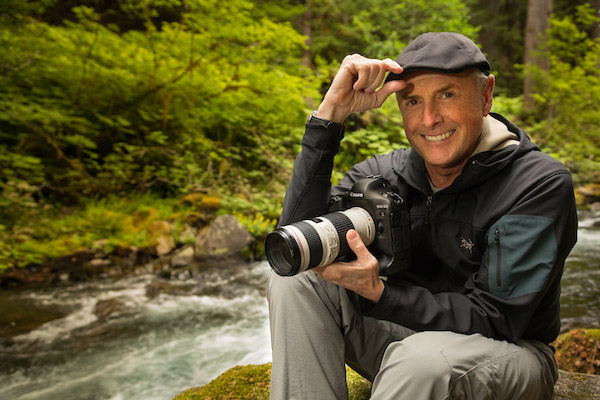
Art Wolfe is an award-winning nature and culture photographer and host of the television series, “Travels to the Edge.” (Photo: courtesy of Art Wolfe)
CURWOOD: So, what is the one picture that you're really itching to take one? One photograph you really want to make.
WOLFE: Yeah, there's a shot that I've had in the back of my mind for over 10 years and it's a extraordinarily beautiful tree that grows on an extraordinarily difficult island to get to. It's an island by the name of Socotra. It's halfway between Yemen and Somalia in the middle of the Indian Ocean, and one of the reasons the tree is such an intrigue for me is that it's so remote, and the trade winds doesn't allow the seeds of other trees to infiltrate this island, and so consequently these trees that grow on this island look outer worldly, and for a tree book I'm working on it would have been a perfect subject. However, you have to pass through Yemen to get to it, and last year the Yemenis rebels, you know, shot a rocket at a Navy ship, and we took out their communications towers. It's not a really good time to be American passing through Yemen.
CURWOOD: Hey, before you go, Art, do you have any tips for those of us who want to take pictures, especially for those of us who go out into nature or go to exotic places as the saying is, “bring back pictures and leave only footsteps”.
WOLFE: I say to people that you first have to care about the subject; otherwise, we're not going to care about it. You know, if you go out there and you're just randomly documenting a subject but you have no interest or emotional attachment to it, I think it shows, and photographers photograph for an audience. It's no different than why writers write or dancers dance. We all want to cultivate an audience and inspire them, educate them, and that's what I try to do with my work. But the most effective ones are where I'm deeply committed to the subject, and I think it comes across ultimately to my audience.
CURWOOD: Art Wolfe is an award-winning nature and culture photographer and host of the television series "Travels to the Edge". Art, thanks so much for taking the time with us, and thank you for publishing "Earth is my Witness"
WOLFE: My pleasure.
Related links:
- Art Wolfe’s website
- Art Wolfe’s Travels to the Edge
- Art Wolfe Instagram
- Earth is My Witness
[MUSIC: Doralice, “Village Tavern” on II, self-published]
CURWOOD: Living on Earth is produced by the World Media Foundation. Our crew includes Naomi Arenberg, Bobby Bascomb, Savannah Christiansen, Jenni Doering, Noble Ingram, Jaime Kaiser, Don Lyman, Helen Palmer, Adelaide Chen, and Jolanda Omari. Tom Tiger engineered our show, with help from Jeff Wade and Jake Rego. Alison Lirish Dean composed our themes. You can hear us anytime at LOE.org -- and like us, please, on our Facebook page -- it’s PRI’s Living on Earth. And we tweet from @LivingonEarth. I'm Steve Curwood. Thanks for listening.
ANNOUNCER1: Funding for Living on Earth comes you, our listeners, and from the University of Massachusetts, Boston, in association with its School for the Environment, developing the next generation of environmental leaders. And from the Grantham Foundation for the protection of the environment, supporting strategic communications and collaboration in solving the world’s most pressing environmental problems. Support also comes from the Energy Foundation, serving the public interest by helping to build a strong, clean, energy economy, from Carl and Judy Ferenbach of Boston, Massachusetts and from SolarCity, America’s solar power provider. SolarCity is dedicated to revolutionizing the way energy is delivered by giving customers a renewable alternative to fossil fuels. Information at 888-997-1703. That’s 888-997-1703.
ANNOUNCER2: PRI. Public Radio International.
Living on Earth wants to hear from you!
Living on Earth
62 Calef Highway, Suite 212
Lee, NH 03861
Telephone: 617-287-4121
E-mail: comments@loe.org
Newsletter [Click here]
Donate to Living on Earth!
Living on Earth is an independent media program and relies entirely on contributions from listeners and institutions supporting public service. Please donate now to preserve an independent environmental voice.
NewsletterLiving on Earth offers a weekly delivery of the show's rundown to your mailbox. Sign up for our newsletter today!
 Sailors For The Sea: Be the change you want to sea.
Sailors For The Sea: Be the change you want to sea.
 The Grantham Foundation for the Protection of the Environment: Committed to protecting and improving the health of the global environment.
The Grantham Foundation for the Protection of the Environment: Committed to protecting and improving the health of the global environment.
 Contribute to Living on Earth and receive, as our gift to you, an archival print of one of Mark Seth Lender's extraordinary wildlife photographs. Follow the link to see Mark's current collection of photographs.
Contribute to Living on Earth and receive, as our gift to you, an archival print of one of Mark Seth Lender's extraordinary wildlife photographs. Follow the link to see Mark's current collection of photographs.
 Buy a signed copy of Mark Seth Lender's book Smeagull the Seagull & support Living on Earth
Buy a signed copy of Mark Seth Lender's book Smeagull the Seagull & support Living on Earth

